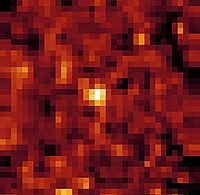


Probable dwarf planet 2002 AW197 as taken by the Spitzer Space Telescope on 13 April 2004
| |
| Discovery[1] | |
|---|---|
| Discovered by | Michael E. Brown, Chad Trujillo, Eleanor F. Helin, Michael Hicks, Kenneth J. Lawrence, Steven H. Pravdo Palomar Observatory (675) |
| Discovery date | January 10, 2002 |
| Designations | |
Designation | (55565) 2002 AW197 |
| none | |
| Cubewano (MPC)[2] Extended (DES)[3] | |
| Orbital characteristics | |
| Epoch December 31, 2006 (JD 2 454 100.5) | |
| Aphelion | 53.503 AU (8.0040 Tm) |
| Perihelion | 41.066 AU (6.1433 Tm) |
| 47.284 AU (7.0736 Tm) | |
| Eccentricity | 0.132 |
| 325.15 a (118,761 d) | |
Average orbital speed | 4.31 km/s |
| 281.945° | |
| Inclination | 24.410° |
| 297.513° | |
| 295.307° | |
| Physical characteristics | |
| Dimensions | 734+116 −108km[4] 700±50 km[5] |
| 8.86h | |
| Albedo | 0.117+.04 −.03[4] 0.17±0.03[5] |
| Temperature | ≈39–40 K[citation needed] |
Spectral type | (moderately red) B-V=0.91, V-R=0.56[6] |
| 20.0 (opposition)[7][8] | |
| 3.26[9] | |
(55565) 2002 AW197 is a classical Kuiper belt object (cubewano). Measurements with the Spitzer Space Telescope have confirmed 2002 AW197 as a probable dwarf planet, although it has not been officially classified as such by the IAU. Light-curve-amplitude analysis shows only small deviations, which suggests that 2002 AW197 is a spheroid with small albedo spots.[10] Tancredi (2010) accepts it as a dwarf planet.[11] Mike Brown's website lists it as a highly likely dwarf planet.[12]
It was discovered on January 10, 2002, by Michael E. Brown et al.[1] It is located near the Kuiper cliff.
Observations of thermal emissions by the Spitzer Space Telescope in 2007 give a diameter of 734+116
−108km[4] and an albedo of 0.117+.04
−.03.[4] The lower size estimate for a dwarf planet is about 400 km.[13]
ESO analysis of spectra reveals a strong red slope and no presence of water ice[14] (in contrast to Quaoar, also red) suggesting organic material (see comparison of colours and typical composition inferred from spectra of the TNOs).
It is currently 46.2 AU from the Sun.[7] It will come to perihelion around 2079.[9]
{{cite web}}: Check date values in: |date= (help)
{{cite arXiv}}: |class= ignored (help)CS1 maint: multiple names: authors list (link)
{{cite journal}}: Unknown parameter |coauthors= ignored (|author= suggested) (help)
{{cite web}}: External link in |publisher={{cite web}}: Check date values in: |date= (help)
{{cite journal}}: CS1 maint: multiple names: authors list (link)
|
| |
|---|---|
|
|
| |
|---|---|
| TNO classes |
|
| Dwarf planets (moons) |
|
| Sednoids |
|